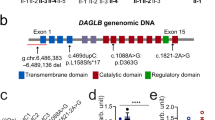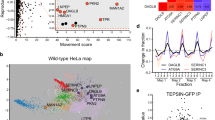Abstract
The endocannabinoid 2-arachidonoylglycerol (2-AG) mediates activity-dependent depression of excitatory neurotransmission at central synapses, but the molecular regulation of 2-AG synthesis is not well understood. Here we identify a functional interaction between the 2-AG synthetic enzyme diacylglycerol lipase-α (DGLα) and calcium/calmodulin dependent protein kinase II (CaMKII). Activated CaMKII interacted with the C-terminal domain of DGLα, phosphorylated two serine residues and inhibited DGLα activity. Consistent with an inhibitory role for CaMKII in 2-AG synthesis, in vivo genetic inhibition of CaMKII increased striatal DGL activity and basal levels of 2-AG, and CaMKII inhibition augmented short-term retrograde endocannabinoid signaling at striatal glutamatergic synapses. Lastly, blockade of 2-AG breakdown using concentrations of JZL-184 that have no effect in wild-type mice produced a hypolocomotor response in mice with reduced CaMKII activity. These findings provide mechanistic insights into the molecular regulation of striatal endocannabinoid signaling with implications for physiological control of motor function.
This is a preview of subscription content, access via your institution
Access options
Subscribe to this journal
Receive 12 print issues and online access
$209.00 per year
only $17.42 per issue
Buy this article
- Purchase on Springer Link
- Instant access to full article PDF
Prices may be subject to local taxes which are calculated during checkout





Similar content being viewed by others
References
Graybiel, A.M., Aosaki, T., Flaherty, A.W. & Kimura, M. The basal ganglia and adaptive motor control. Science 265, 1826–1831 (1994).
Packard, M.G. & Knowlton, B.J. Learning and memory functions of the basal ganglia. Annu. Rev. Neurosci. 25, 563–593 (2002).
Kravitz, A.V., Tye, L.D. & Kreitzer, A.C. Distinct roles for direct and indirect pathway striatal neurons in reinforcement. Nat. Neurosci. 15, 816–818 (2012).
Gerdeman, G.L., Ronesi, J. & Lovinger, D.M. Postsynaptic endocannabinoid release is critical to long-term depression in the striatum. Nat. Neurosci. 5, 446–451 (2002).
Kreitzer, A.C. & Malenka, R.C. Dopamine modulation of state-dependent endocannabinoid release and long-term depression in the striatum. J. Neurosci. 25, 10537–10545 (2005).
Shen, Y.S., Gao, H. & Yao, H. Spike timing-dependent synaptic plasticity in visual cortex: a modeling study. J. Comput. Neurosci. 18, 25–39 (2005).
Tanimura, A. et al. The endocannabinoid 2-arachidonoylglycerol produced by diacylglycerol lipase alpha mediates retrograde suppression of synaptic transmission. Neuron 65, 320–327 (2010).
Wilson, R.I., Kunos, G. & Nicoll, R.A. Presynaptic specificity of endocannabinoid signaling in the hippocampus. Neuron 31, 453–462 (2001).
Di Filippo, M. et al. The endocannabinoid system in Parkinson's disease. Curr. Pharm. Des. 14, 2337–2347 (2008).
Muller-Vahl, K.R., Schneider, U., Kolbe, H. & Emrich, H.M. Treatment of Tourette's syndrome with delta-9-tetrahydrocannabinol. Am. J. Psychiatry 156, 495 (1999).
Blazquez, C. et al. Loss of striatal type 1 cannabinoid receptors is a key pathogenic factor in Huntington's disease. Brain 134, 119–136 (2011).
Devane, W.A. & Axelrod, J. Enzymatic synthesis of anandamide, an endogenous ligand for the cannabinoid receptor, by brain membranes. Proc. Natl. Acad. Sci. USA 91, 6698–6701 (1994).
Sugiura, T. et al. 2-Arachidonoylglycerol: a possible endogenous cannabinoid receptor ligand in brain. Biochem. Biophys. Res. Commun. 215, 89–97 (1995).
Ade, K.K. & Lovinger, D.M. Anandamide regulates postnatal development of long-term synaptic plasticity in the rat dorsolateral striatum. J. Neurosci. 27, 2403–2409 (2007).
Oudin, M.J., Hobbs, C. & Doherty, P. DAGL-dependent endocannabinoid signalling: roles in axonal pathfinding, synaptic plasticity and adult neurogenesis. Eur. J. Neurosci. 34, 1634–1646 (2011).
Yoshino, H. et al. Postsynaptic diacylglycerol lipase alpha mediates retrograde endocannabinoid suppression of inhibition in mouse prefrontal cortex. J. Physiol. (Lond.) 589, 4857–4884 (2011).
Gao, Y. et al. Loss of retrograde endocannabinoid signaling and reduced adult neurogenesis in diacylglycerol lipase knock-out mice. J. Neurosci. 30, 2017–2024 (2010).
Bisogno, T. et al. Cloning of the first sn1-DAG lipases points to the spatial and temporal regulation of endocannabinoid signaling in the brain. J. Cell Biol. 163, 463–468 (2003).
Jung, K.M. et al. A key role for diacylglycerol lipase-alpha in metabotropic glutamate receptor-dependent endocannabinoid mobilization. Mol. Pharmacol. 72, 612–621 (2007).
Uchigashima, M. et al. Subcellular arrangement of molecules for 2-arachidonoyl-glycerol-mediated retrograde signaling and its physiological contribution to synaptic modulation in the striatum. J. Neurosci. 27, 3663–3676 (2007).
Lerner, T.N. & Kreitzer, A.C. RGS4 is required for dopaminergic control of striatal LTD and susceptibility to Parkinsonian motor deficits. Neuron 73, 347–359 (2012).
Lerner, T.N., Horne, E.A., Stella, N. & Kreitzer, A.C. Endocannabinoid signaling mediates psychomotor activation by adenosine A2A antagonists. J. Neurosci. 30, 2160–2164 (2010).
Wilson, R.I. & Nicoll, R.A. Endogenous cannabinoids mediate retrograde signalling at hippocampal synapses. Nature 410, 588–592 (2001).
Kreitzer, A.C. & Regehr, W.G. Retrograde signaling by endocannabinoids. Curr. Opin. Neurobiol. 12, 324–330 (2002).
Kreitzer, A.C. & Regehr, W.G. Retrograde inhibition of presynaptic calcium influx by endogenous cannabinoids at excitatory synapses onto Purkinje cells. Neuron 29, 717–727 (2001).
Ohno-Shosaku, T., Maejima, T. & Kano, M. Endogenous cannabinoids mediate retrograde signals from depolarized postsynaptic neurons to presynaptic terminals. Neuron 29, 729–738 (2001).
Hashimotodani, Y. et al. Phospholipase Cbeta serves as a coincidence detector through its Ca2+ dependency for triggering retrograde endocannabinoid signal. Neuron 45, 257–268 (2005).
Maejima, T. et al. Synaptically driven endocannabinoid release requires Ca2+-assisted metabotropic glutamate receptor subtype 1 to phospholipase Cbeta4 signaling cascade in the cerebellum. J. Neurosci. 25, 6826–6835 (2005).
Maejima, T., Ohno-Shosaku, T. & Kano, M. Endogenous cannabinoid as a retrograde messenger from depolarized postsynaptic neurons to presynaptic terminals. Neurosci. Res. 40, 205–210 (2001).
Robison, A.J., Bartlett, R.K., Bass, M.A. & Colbran, R.J. Differential modulation of Ca2+/calmodulin-dependent protein kinase II activity by regulated interactions with N-methyl-D-aspartate receptor NR2B subunits and alpha-actinin. J. Biol. Chem. 280, 39316–39323 (2005).
Robison, A.J. et al. Multivalent interactions of calcium/calmodulin-dependent protein kinase II with the postsynaptic density proteins NR2B, densin-180, and alpha-actinin-2. J. Biol. Chem. 280, 35329–35336 (2005).
Miller, S.G. & Kennedy, M.B. Regulation of brain type II Ca2+/calmodulin-dependent protein kinase by autophosphorylation: a Ca2+-triggered molecular switch. Cell 44, 861–870 (1986).
Nikandrova, Y.A., Jiao, Y., Baucum, A.J., Tavalin, S.J. & Colbran, R.J. Ca2+/calmodulin-dependent protein kinase II binds to and phosphorylates a specific SAP97 splice variant to disrupt association with AKAP79/150 and modulate alpha-amino-3-hydroxy-5-methyl-4-isoxazolepropionic acid-type glutamate receptor (AMPAR) activity. J. Biol. Chem. 285, 923–934 (2010).
Grueter, C.E. et al. L-type Ca2+ channel facilitation mediated by phosphorylation of the beta subunit by CaMKII. Mol. Cell 23, 641–650 (2006).
Giese, K.P., Fedorov, N.B., Filipkowski, R.K. & Silva, A.J. Autophosphorylation at Thr286 of the alpha calcium-calmodulin kinase II in LTP and learning. Science 279, 870–873 (1998).
Miller, S.G., Patton, B.L. & Kennedy, M.B. Sequences of autophosphorylation sites in neuronal type II CaM kinase that control Ca2+-independent activity. Neuron 1, 593–604 (1988).
Dinh, T.P. et al. Brain monoglyceride lipase participating in endocannabinoid inactivation. Proc. Natl. Acad. Sci. USA 99, 10819–10824 (2002).
Ohno-Shosaku, T., Hashimotodani, Y., Maejima, T. & Kano, M. Calcium signaling and synaptic modulation: regulation of endocannabinoid-mediated synaptic modulation by calcium. Cell Calcium 38, 369–374 (2005).
Kreitzer, A.C. & Malenka, R.C. Endocannabinoid-mediated rescue of striatal LTD and motor deficits in Parkinson's disease models. Nature 445, 643–647 (2007).
Shen, W., Flajolet, M., Greengard, P. & Surmeier, D.J. Dichotomous dopaminergic control of striatal synaptic plasticity. Science 321, 848–851 (2008).
Gong, S. et al. A gene expression atlas of the central nervous system based on bacterial artificial chromosomes. Nature 425, 917–925 (2003).
Maejima, T., Hashimoto, K., Yoshida, T., Aiba, A. & Kano, M. Presynaptic inhibition caused by retrograde signal from metabotropic glutamate to cannabinoid receptors. Neuron 31, 463–475 (2001).
Aravanis, A.M. et al. An optical neural interface: in vivo control of rodent motor cortex with integrated fiberoptic and optogenetic technology. J. Neural Eng. 4, S143–S156 (2007).
Wiley, J.L. & Martin, B.R. Cannabinoid pharmacological properties common to other centrally acting drugs. Eur. J. Pharmacol. 471, 185–193 (2003).
Long, J.Z. et al. Selective blockade of 2-arachidonoylglycerol hydrolysis produces cannabinoid behavioral effects. Nat. Chem. Biol. 5, 37–44 (2009).
Zhang, L., Wang, M., Bisogno, T., Di Marzo, V. & Alger, B.E. Endocannabinoids generated by Ca2+ or by metabotropic glutamate receptors appear to arise from different pools of diacylglycerol lipase. PLoS ONE 6, e16305 (2011).
Jenkins, M.A. et al. Ca2+-dependent facilitation of Cav1.3 Ca2+ channels by densin and Ca2+/calmodulin-dependent protein kinase II. J. Neurosci. 30, 5125–5135 (2010).
Gustin, R.M. et al. Loss of Thr286 phosphorylation disrupts synaptic CaMKIIalpha targeting, NMDAR activity and behavior in pre-adolescent mice. Mol. Cell Neurosci. 47, 286–292 (2011).
Picconi, B. et al. Abnormal Ca2+-calmodulin-dependent protein kinase II function mediates synaptic and motor deficits in experimental parkinsonism. J. Neurosci. 24, 5283–5291 (2004).
Brown, A.M., Deutch, A.Y. & Colbran, R.J. Dopamine depletion alters phosphorylation of striatal proteins in a model of Parkinsonism. Eur. J. Neurosci. 22, 247–256 (2005).
Keimpema, E. et al. Differential subcellular recruitment of monoacylglycerol lipase generates spatial specificity of 2-arachidonoyl glycerol signaling during axonal pathfinding. J. Neurosci. 30, 13992–14007 (2010).
Katona, I. et al. Molecular composition of the endocannabinoid system at glutamatergic synapses. J. Neurosci. 26, 5628–5637 (2006).
Eng, J.K., McCormack, A.L., Yates, I. & John, R. An approach to correlate tandem mass spectral data of peptides with amino acid sequences in a protein database. J. Am. Soc. Mass Spectrom. 5, 976–989 (1994).
Ma, Z.Q. et al. IDPicker 2.0: Improved protein assembly with high discrimination peptide identification filtering. J. Proteome Res. 8, 3872–3881 (2009).
MacLean, B. et al. Skyline: an open source document editor for creating and analyzing targeted proteomics experiments. Bioinformatics 26, 966–968 (2010).
Patel, S., Kingsley, P.J., Mackie, K., Marnett, L.J. & Winder, D.G. Repeated homotypic stress elevates 2-arachidonoylglycerol levels and enhances short-term endocannabinoid signaling at inhibitory synapses in basolateral amygdala. Neuropsychopharmacology 34, 2699–2709 (2009).
Sumislawski, J.J., Ramikie, T.S. & Patel, S. Reversible gating of endocannabinoid plasticity in the amygdala by chronic stress: a potential role for monoacylglycerol lipase inhibition in the prevention of stress-induced behavioral adaptation. Neuropsychopharmacology 36, 2750–2761 (2011).
Acknowledgements
This work was supported by US National Institutes of Health (T32-NS007491 and T32-MH065215 to B.C.S.; K01-NS073700 to A.J.B.; K05-DA021696 and R01-DA011322 to K.M.; R01-AA019455 to D.G.W.; K08-MH090412 to S.P.; and R01-MH063232 and R01-NS078291 to R.J.C.), the Michael J. Fox Foundation (R.J.C.) and the Luton Society (S.P.). The content is solely the responsibility of the authors and does not necessarily represent the official views of the US National Institutes of Health. Behavioral studies were performed in the Murine Neurobehavior Core and mass spectrometry and proteomics studies were performed at the Mass Spectrometry Research Center, both at Vanderbilt University Medical Center. We thank B. Cravatt (The Scripps Research Institute) for plasmids encoding DGLα-V5 and DGLβ-V5.
Author information
Authors and Affiliations
Contributions
B.C.S. and A.J.B. performed all of the immunoprecipitation studies and LC/MS quantification of striatal lipid levels. B.C.S. performed all of the DGL activity assays. V.S.C. carried out the GST cosedimentation assay. B.C.S. and X.W. generated the GST-fusion proteins and DGLα mutants, and performed the phosphorylation site identification studies. B.C.S. and K.L.R. performed the LC/MS analysis of phosphorylation sites. B.C.S., T.S.R. and S.P. conducted the electrophysiology experiments. B.C.S. and T.R. carried out the behavioral experiments. B.C.S. analyzed data from all experiments. N.J.-S. performed the T286 phosphorylation measurements in HEK293 cells. K.M. contributed the DGL antibodies. B.C.S., D.G.W., S.P. and R.J.C. designed the experiments. B.C.S., S.P. and R.J.C. prepared the manuscript with input from all other authors.
Corresponding authors
Ethics declarations
Competing interests
The authors declare no competing financial interests.
Supplementary information
Supplementary Text and Figures
Supplementary Tables 1 and 2, Supplementary Figures 1–7 (PDF 6225 kb)
Rights and permissions
About this article
Cite this article
Shonesy, B., Wang, X., Rose, K. et al. CaMKII regulates diacylglycerol lipase-α and striatal endocannabinoid signaling. Nat Neurosci 16, 456–463 (2013). https://doi.org/10.1038/nn.3353
Received:
Accepted:
Published:
Issue Date:
DOI: https://doi.org/10.1038/nn.3353
This article is cited by
-
Mobilization of endocannabinoids by midbrain dopamine neurons is required for the encoding of reward prediction
Nature Communications (2023)
-
Inflammation and Nitro-oxidative Stress as Drivers of Endocannabinoid System Aberrations in Mood Disorders and Schizophrenia
Molecular Neurobiology (2022)
-
Neuronal Nitric Oxide Synthase Critically Regulates the Endocannabinoid Pathway in the Murine Cerebellum During Development
The Cerebellum (2022)
-
The sociability spectrum: evidence from reciprocal genetic copy number variations
Molecular Autism (2020)
-
Interaction between NMDA Receptor- and Endocannabinoid-Mediated Modulation of Nociceptive Synapses
Scientific Reports (2019)



